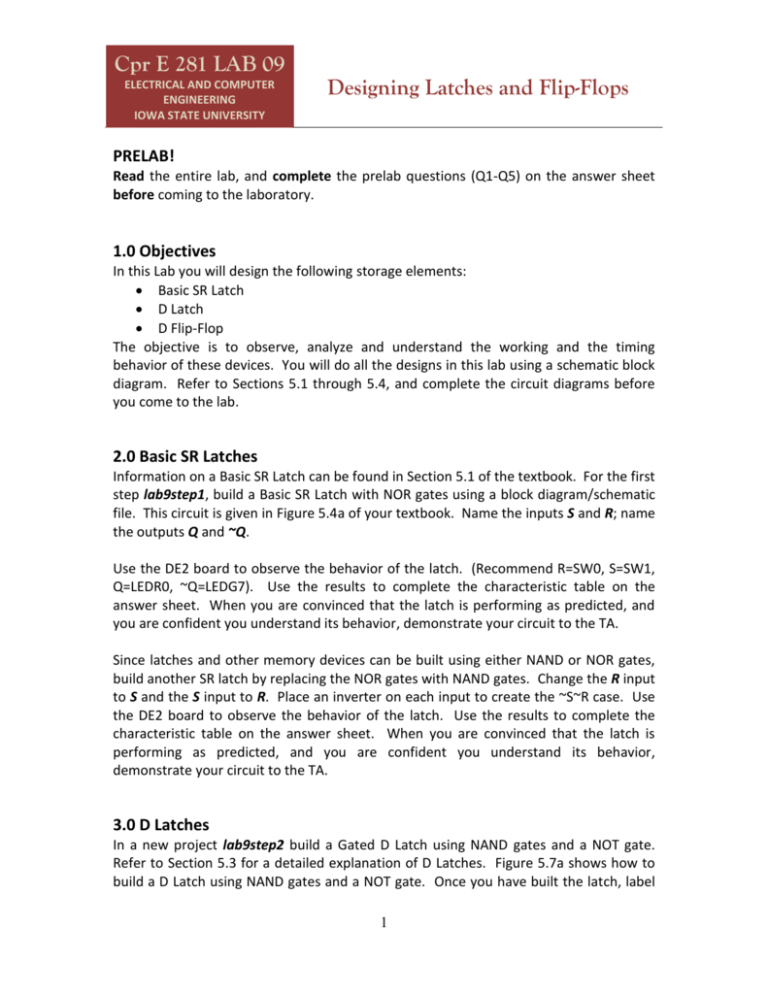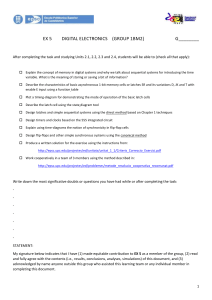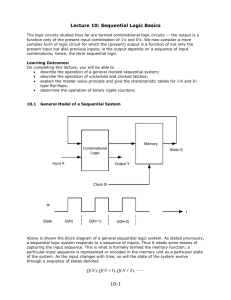Introduction to Truth Tables, Logic Expressions and Circuit
advertisement

Cpr E 281 LAB 09 ELECTRICAL AND COMPUTER ENGINEERING IOWA STATE UNIVERSITY Designing Latches and Flip-Flops PRELAB! Read the entire lab, and complete the prelab questions (Q1-Q5) on the answer sheet before coming to the laboratory. 1.0 Objectives In this Lab you will design the following storage elements: Basic SR Latch D Latch D Flip-Flop The objective is to observe, analyze and understand the working and the timing behavior of these devices. You will do all the designs in this lab using a schematic block diagram. Refer to Sections 5.1 through 5.4, and complete the circuit diagrams before you come to the lab. 2.0 Basic SR Latches Information on a Basic SR Latch can be found in Section 5.1 of the textbook. For the first step lab9step1, build a Basic SR Latch with NOR gates using a block diagram/schematic file. This circuit is given in Figure 5.4a of your textbook. Name the inputs S and R; name the outputs Q and ~Q. Use the DE2 board to observe the behavior of the latch. (Recommend R=SW0, S=SW1, Q=LEDR0, ~Q=LEDG7). Use the results to complete the characteristic table on the answer sheet. When you are convinced that the latch is performing as predicted, and you are confident you understand its behavior, demonstrate your circuit to the TA. Since latches and other memory devices can be built using either NAND or NOR gates, build another SR latch by replacing the NOR gates with NAND gates. Change the R input to S and the S input to R. Place an inverter on each input to create the ~S~R case. Use the DE2 board to observe the behavior of the latch. Use the results to complete the characteristic table on the answer sheet. When you are convinced that the latch is performing as predicted, and you are confident you understand its behavior, demonstrate your circuit to the TA. 3.0 D Latches In a new project lab9step2 build a Gated D Latch using NAND gates and a NOT gate. Refer to Section 5.3 for a detailed explanation of D Latches. Figure 5.7a shows how to build a D Latch using NAND gates and a NOT gate. Once you have built the latch, label 1 Cpr E 281 LAB 09 ELECTRICAL AND COMPUTER ENGINEERING IOWA STATE UNIVERSITY Designing Latches and Flip-Flops the inputs Clk and D, and outputs Q and ~Q. Use the DE2 board to observe the behavior of the latch. Since the pushbuttons can be a bit inconsistent it would be better to use a toggle switch to manually control the clock signal. (Recommend Clk=SW0, D=SW1, Q=LEDR0, ~Q=LEDG7). When you are convinced that the latch is performing as predicted, and you are confident you understand its behavior, complete the timing diagram on the answer sheet, (pulse your clock signal once with D low before you start), and demonstrate your circuit to the TA. Create a Symbol for this Latch. 4.0 D Flip-Flops Refer to Section 5.4 for a detailed explanation of D Flip-Flops. In a new project lab9step3a, use the Gated D Latch that you built to design a NegativeEdge-Triggered Master-Slave D Flip-Flop. Section 5.4.1 discusses this design. Refer to Figure 5.9a. Use the DE2 board to observe the behavior of the latch. When you are convinced that the latch is performing as predicted, and you are confident you understand its behavior, complete the timing diagram on the answer sheet, (pulse your clock signal once with D low before you start), and demonstrate your circuit to the TA. In a new project (lab9step3b) you will design a Positive-Edge-Triggered D Flip-Flop using NAND gates. Section 5.4.2 discusses this design. Please use Figure 5.11a as a guide for this step. Use the DE2 board to observe the behavior of the latch. When you are convinced that the latch is performing as predicted, and you are confident you understand its behavior, complete the timing diagram on the answer sheet, and demonstrate your circuit to the TA. 5.0 Complete You are done with this lab. Close all lab files, exit Quartus II, log off the computer, and hand in your answer sheet. Don’t forget to write down your name and your lab section number. 2











